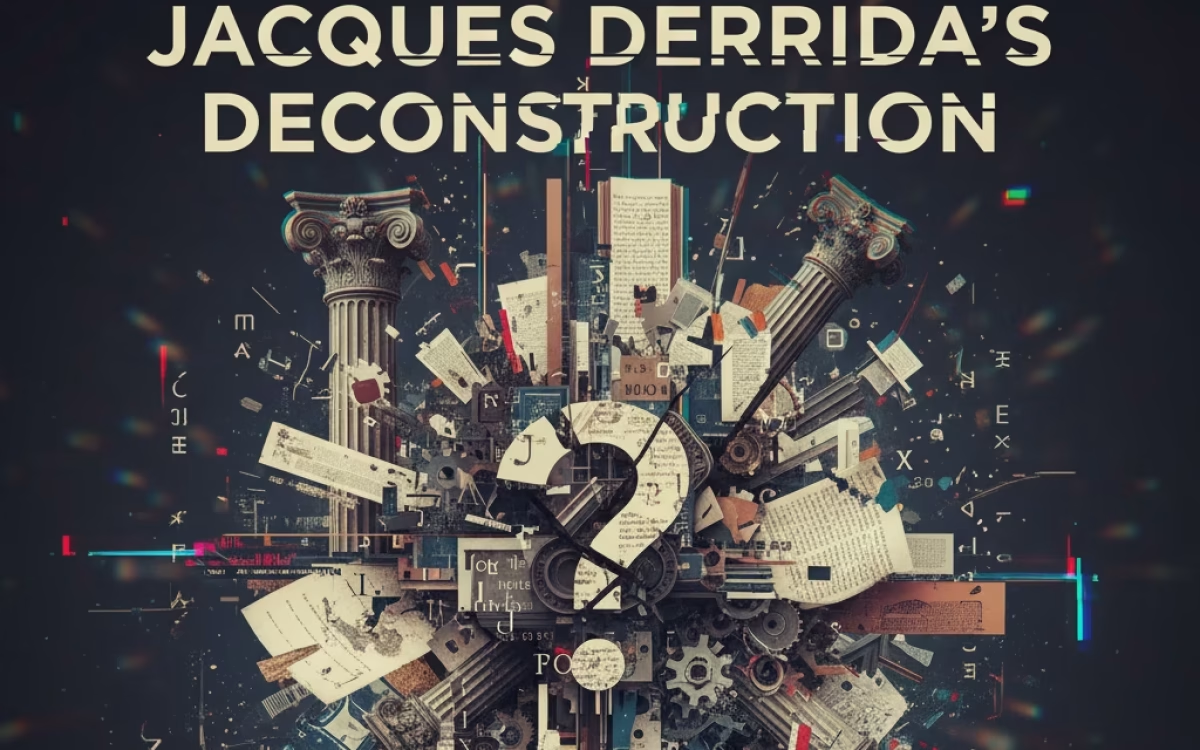Introduction
“Jacques Derrida’s Deconstruction” occupies a seminal position in contemporary literary theory, philosophy, and cultural studies. Jacques Derrida, a pivotal figure in twentieth-century thought, irreversibly shaped academic discourse with his theory of deconstruction—a method for revealing the inherent instability in texts and the fundamental indeterminacy of meaning. In the intricate interplay between language, meaning, and interpretation, deconstruction actively interrogates foundational certainties, exposes internal contradictions, and challenges privileged hierarchies embedded in the Western tradition, thereby transforming how readers engage with texts—whether literary, philosophical, or political.
Jacques Derrida’s Deconstruction: Origins and Context
Derrida’s intellectual journey began amidst the ferment of postwar French philosophy, where existentialism, structuralism, and phenomenology were reshaping the intellectual landscape. He drew inspiration—and critical opposition—from figures like Husserl, Heidegger, and Saussure, as well as from structuralist linguistics and psychoanalysis. Against this rich backdrop, deconstruction arose not as an abstract philosophical system but as a practical method for reading texts, destabilizing certainties, and interrogating the binary structures underpinning the “metaphysics of presence”.
The roots of deconstruction stem from linguistic theory. Derrida drew profound influence from Saussure’s structuralism, which emphasised the relational nature of signs—specifically, the signifier and the signified. Structuralism aimed to uncover stable structures beneath language. However, Derrida argued that meaning constantly defers and never achieves conclusive stability. He called this process “différance.”. Deconstruction, therefore, develops at the crossroads of linguistics, philosophy, and literary criticism, persistently resisting any dogmatic closure. FULL TEXT
Jacques Derrida’s Deconstruction: Core Concepts and Methodology
Binary Oppositions and Hierarchies
Central to Derrida’s deconstruction is the notion of binary opposition. Western thought, from Plato to modern philosophy, tends to organize itself around pairs: presence/absence, speech/writing, reason/emotion, male/female, and others. These pairs are not neutral; tradition privileges one term over the other, endowing “presence” with primacy over “absence,” for example. Deconstruction sets out to disrupt these hierarchies, first by reversing them—making the marginalised term central—and, crucially, by showing that the binary itself is a construct, whose oppositional logic is neither natural nor uncontested.
The Logic of Différance: Meaning as Deferral
Derrida introduces différance—a neologism combining “difference” and “deferral”—to describe the endless play of meaning in language. Words acquire meaning not by linking unequivocally to referents (“signifieds”) but through their never-completed differentiation from other words. Meaning is thus always “deferred”, never present in full. The logic of différance undermines any conception of meaning as fixed, final, or given, and instead posits language as an open system, producing a multiplicity of potential interpretations.
The Deconstructive Reading: Aporetic Structure
A deconstructive reading does not seek to offer a single, final interpretation. Rather, it follows the logic of “aporia”—moments where the text resists resolution, exposes incompatibilities, or stalls understanding. Deconstruction seeks to draw out these aporias, revealing the irreducible complexity and instability of texts. This method is applied not only to literature but also to philosophy, legal theory, and political discourse.
Jacques Derrida’s Deconstruction: Literary Criticism
Deconstruction’s most visible legacy lies in literary criticism, where it radically reshaped ideas of interpretation, authorship, and textual meaning. Rather than searching for a “correct” reading, deconstruction insists that all readings are provisional, contingent, and open to revision. The text is no longer a discrete whole, unified by authorial intention, but a field of competing meanings.
In practical terms, deconstruction exposes the contradictions, ellipses, and ambiguities at the heart of literary texts. It demonstrates that narrative unity and closure are impossible and that every attempt to fix meaning merely foregrounds new uncertainties. The result is an academic methodology that resists certainty, values multiplicity, and foregrounds the limits of interpretation.
Jacques Derrida’s Deconstruction: Western Philosophy
Derrida’s critique targets the “metaphysics of presence”, a concept he derives from Heidegger and extends to the entire Western philosophical tradition. This metaphysics privileges immediacy, actuality, and self-evidence. It organises thought around the idea of primary presence, which often appears in speech, as opposed to a derivative absence, such as writing. Deconstruction challenges and unmasks this privilege by demonstrating that absence is not secondary but foundational. In Derrida’s analysis, writing does more than merely represent speech; it fundamentally shapes and disrupts the very nature of meaning.
The process extends beyond simple reversal. Whereas traditional philosophy seeks closure, synthesis, or dialectical resolution—most famously in Hegel—deconstruction refuses to accept finality. Undecidables (terms that cannot be assimilated to either pole of a binary opposition) are privileged, highlighting irreconcilable tensions and the productive power of paradox.
Jacques Derrida’s Deconstruction: Political and Ethical Implications
Deconstruction’s ramifications are not confined to academic theory. In law, politics, and ethics, Derrida’s strategy probes foundational binaries: law/justice, violence/order, insider/outsider. For Derrida, deconstruction is “a problematization of the foundations of law, morality, and politics.” Rather than legitimizing existing structures, deconstruction uncovers how hierarchies form, how power is exerted, and whose voices are suppressed.
Importantly, Derrida’s later work emphasizes ethical responsibility, particularly the “absolute singularity” of responsibility to the Other. Here, deconstruction moves towards an ethics of alterity (otherness), celebrating the irreducibility of difference and challenging the universalising logic of modernity.
Jacques Derrida’s Deconstruction: Analytical Steps
The academic application of deconstruction follows recognisable procedures:
Identify Binary Oppositions: Locate pairs in the text whose oppositional logic structures meaning (e.g., male/female, reason/emotion).
Question Privilege: Examine which term is privileged and how this hierarchy functions.
Reverse and displace: flip the hierarchy, foreground the marginalised term, and destabilise the opposition.
Expose Aporia: Seek out contradictions, ambiguities, and unsolvable tensions.
Embrace Multiplicity: Accept provisionality, honouring the text’s plurality and indeterminacy.
This methodology aims to avoid the pitfalls of simple inversion (which only re-establishes the hierarchy in reverse) and instead pursues a radical opening—inviting new ways of reading, questioning, and theorising.
Illustrative Examples: Derrida’s Readings
Derrida’s own scholarship provides models for academic deconstruction. His readings of Rousseau, Plato, and Husserl meticulously identify binary structures and probe their instability. For example, in Of Grammatology, Derrida interrogates Rousseau’s privileging of speech over writing, contending that writing is neither secondary nor derivative but fundamental to the constitution of meaning.
This critical style is replicated across disciplines. In law (Force of Law), Derrida dissects the binary of law/justice, demonstrating that foundational oppositions are fraught with internal contradictions. In his essays on hospitality, Derrida exposes the paradoxes inherent in welcoming the Other—a gesture rendered, in practice, both necessary and impossible.
Criticisms and Academic Debates Surrounding Deconstruction
No academic theory is without controversy. Critics argue that deconstruction leads inexorably to relativism or nihilism, undermining the possibility of meaningful interpretive engagement. Others contend that Derrida’s prose, dense and heavily rhetorical, obscures more than it illuminates. Yet defenders counter that deconstruction expands the horizons of thought, enabling readers to recognise the limits and potential of interpretation itself.
Some philosophers complain that deconstruction’s obsession with language and textuality risks disconnecting philosophy from reality and from pressing ethical and political concerns. Derrida, however, insists that language is itself an irreducible condition for human experience; to ignore its complexity is to risk profound misunderstanding. Academic debates thus generate a vibrant dialogue around the legacy and future of deconstruction.
Jacques Derrida’s Deconstruction: Global Influence
Since the 1970s, scholars and practitioners around the world have increasingly embraced deconstruction across diverse disciplines, including literature, philosophy, anthropology, sociology, linguistics, law, and political theory. Postcolonial studies, feminist theory, and multicultural literary analysis especially emphasise and apply deconstruction’s powerful tools. These tools expose dominant narratives and help reclaim suppressed histories.
In regions such as India, South Africa, and the United Kingdom, scholars have used deconstruction to destabilise Eurocentric binaries, recentre marginalised traditions, and critically examine power structures at both local and global levels. The method’s openness encourages participation from a wide range of cultural and theoretical perspectives, making it uniquely adaptable to varied academic contexts.
Jacques Derrida’s Deconstruction: Major Works and Key Terms
Derrida’s theoretical innovations are grounded in a range of seminal texts, including Of Grammatology, Writing and Difference, Margins of Philosophy, and Dissemination. Each work develops critical terminology—différance, trace, supplement, pharmakon, aporia—that underpins deconstructive analysis.
Différance: Difference and deferral, underpinning the instability of meaning.
Trace: The presence of other meanings within any term or concept.
Supplement: That which adds to or enhances, and also destabilises, the supposed “original”.
Pharmakon: Both remedy and poison, a term refusing binary fixation.
Academic discussion regularly engages these terms, deepening understanding and expanding the scope of analysis. EXPLORE OTHER AUTHORS
Conclusion
Jacques Derrida’s deconstruction constitutes more than just a theory; it represents a rigorous academic practice, a strategic approach to engaging with texts, and a method for problematising established certainties. By persistently interrogating binary oppositions and resisting definitive closure, deconstruction has become indispensable across a broad spectrum of fields—from literature to law. At its core, deconstruction invites scholars to rethink prevailing assumptions, question foundational concepts, and see familiar ideas anew.
For contemporary scholars, embracing Derrida’s deconstruction means accepting the complexities and provisional nature of meaning. Moreover, it requires recognising interpretation as an ongoing process of negotiation—one marked by intellectual humility, critical rigor, and openness to difference. In an era increasingly sceptical of absolute certainty, deconstruction offers a vital reminder: meaning is never fixed. Instead, it remains fluid, plural, and always open to revision.
FAQs: Derrida’s Deconstruction in Practice
1. What is the core aim of Derrida’s deconstruction?
It is to expose and challenge the internal structures of binary opposition and privilege that underpin texts and traditions, demonstrating the instability and multiplicity of meaning.
2. How does deconstruction differ from traditional literary criticism?
Deconstruction challenges the notion that texts possess a single, stable meaning safeguarded by authorial intention, instead revealing irreducible complexity and openness to interpretation.
3. Can deconstruction be applied to scientific or legal texts?
Yes. Deconstruction’s method is adaptable, enabling the critique of foundational assumptions and binary thinking in a wide variety of fields, including science, law, and politics.
4. Does deconstruction deny meaning altogether?
No. Derrida does not deny meaning but refuses the idea of a single, “correct” meaning. The process enables richer, more democratic exploration of a text’s possible interpretations.
5. How is deconstruction relevant to multicultural and postcolonial analysis?
By challenging dominant structures and hierarchies, deconstruction empowers marginalised voices, unveils suppressed histories, and facilitates pluralistic approaches to knowledge and interpretation.





